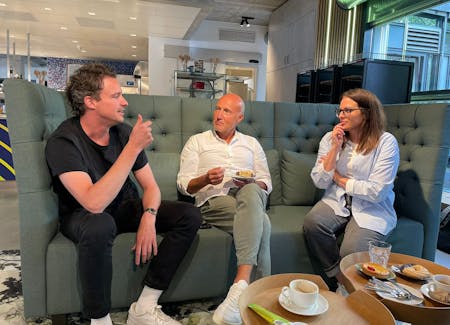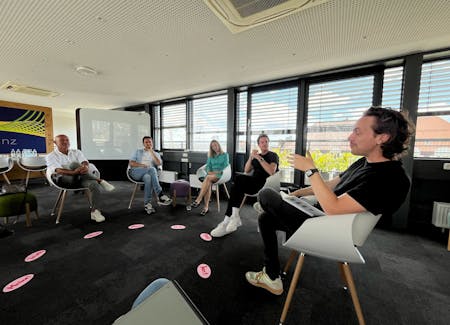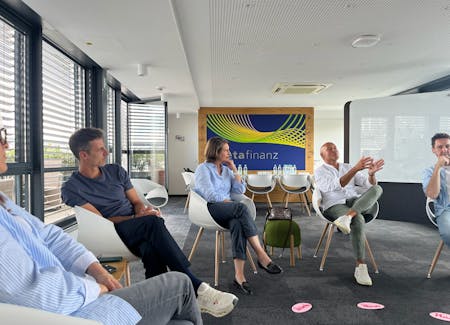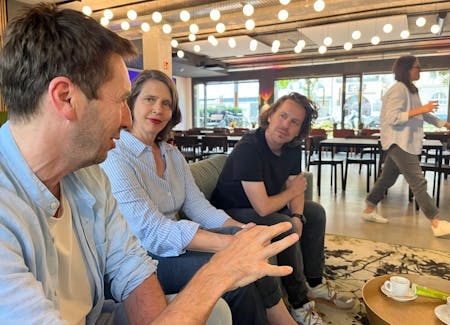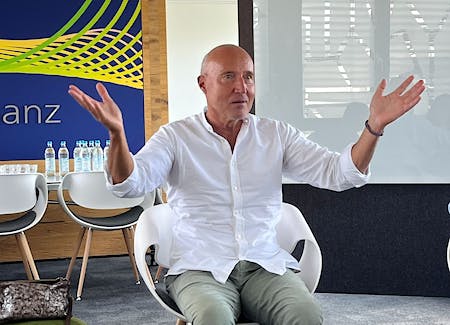Inside Metafinanz: How 850 People Run a Consulting Business Without Managers

When we stepped into the metafinanz office in Munich last week, we weren’t sure what to expect.
After all, this was a consultancy owned by Allianz - the very definition of corporate Germany.
But what we found?
No traditional hierarchy. No managers. No top down control.
Instead, 850 people running a radically decentralized organization. Full of self-organized teams, internal service markets, and a vision that keeps evolving.
It wasn’t always like this.
In fact, the story of how they got here is just as impressive as the system they’ve built.
2016: The breaking point
On the surface, metafinanz was doing well. Business was steady. Projects delivered.
But something was off, and everyone felt it.
Inside, the organization was sluggish. Layered. Slow to decide, slow to adapt.
“We changed the org chart every year,” CEO Rainer Göttmann recalled. “But it was always just one department moved to another position. Nothing changed underneath.”
In fact, they had developed a kind of dark talent (like most organizations): pretending to change.
“We were really pretty good at change processes at metafinanz,” one team member said with a grin. “We did it every year. And we were pretty good at it. But we changed nothing in the daily business.”
It was a ritual. A performance. Org charts came and went, but the way people actually worked stayed frozen in time.
That’s when Rainer asked the question that flipped the switch:
“If you were the owner of this company, would you do it this way?”
The answer came fast. And unanimous.
“No.”
What came next wasn’t a strategy. It wasn’t a framework. It was a story.
“There was no PowerPoint,” someone remembered. “There was just a story from Rainer. How he believes metafinanz could look like in some months, some years.”
It was a story about trust. About real ownership. About doing away with the illusion of control and giving people the space to lead.
It wasn’t a change initiative, but more like a call to courage.
Rainer ended with one more bold move: a deadline.
“We set a date: May 1st.”
On that day, metafinanz would walk away from the old structure. And leap into something radically different.
2017: The big bang
May 1st came.
No more departments. No more middle management. No more waiting for permission.
The entire company reorganized into self-managed teams, now known as business areas. Each one responsible for its own strategy, pricing, finances, hiring, and delivery.
There was no step-by-step rollout. No giant transformation plan. Just action.
“We wanted to start,” one person said. “Not think. Not analyze. Just start.”
It was chaotic at times. Some people didn’t know what to do. Some missed the clarity of the old system. But the shift was undeniable:
People stopped asking for permission. They started making decisions.
Instead of building a structure around control, they were building one around trust and initiative.
And somehow, it worked.
The leap didn’t just change the structure. It changed the culture. Not through endless training programs, but by fundamentally changing the operating system.
What emerged: 80+ self-organized teams
Today, metafinanz is made up of around 80 business areas: self-organized teams that act like mini-companies inside the firm.
Each team defines its own strategy, goals, pricing, service quality, and even its own hiring.
Want to get a sense for how decentralized power and decision making has become?
Every consultant can sign a customer contract now. Impressive, right?
What holds it all together? A few simple criteria for starting and running a team:
- A clear purpose
- At least five committed people
- A profitable business case
- Alignment with metafinanz’s overall direction
That last part, alignment, is key.
“We don’t approve teams top-down,” someone said. “But we do alignment talks. You can’t just start a car dealership and call it a business area.”
So while autonomy is real, it lives within a shared direction.
This combination (high autonomy with lightweight alignment) is what gives the system its stability.
This is the kind of setup we teach in our 6-week masterclass. It shows how these powerful principles actually play out in real cases.
It allows for speed, ownership, and adaptation without descending into chaos.
Support shops: Compete or be ignored
Self-managed teams still need support. Think of support like IT, HR, and legal. You can't expect all teams to have an expertise in that.
At metafinanz, these aren’t departments. They’re support shops.
Each shop offers internal services, but here’s the twist: teams aren’t forced to use them.
“If we don’t like the offer, we go outside,” one employee said.
That dynamic creates a healthy tension. Internal services have to compete. If they don’t deliver value, they lose their “customers.”
We've seen this approach at other self-managed companies like Haier, Handelsbanken, and Centigo.
It finally puts the "support" back into support functions.
Transparency without control
With 80+ self-managed teams, how do you stay aligned?
At metafinanz, the answer is simple: make everything visible.
Every team has a dashboard.
Revenues, margins, utilization: it’s all open for others to see. But it’s not about surveillance. It’s about shared understanding.
Instead of setting internal performance targets, the company defines margin corridors: benchmarks based on market realities.
“If you’re working in AI, the corridor is higher. If you’re in software development, it’s lower,” one person explained.
The corridor isn’t a goal.
It’s a reflection of what’s realistic in your space. No one’s chasing arbitrary KPIs. Teams stay grounded in the market, not the mood of a manager.
The corridors are transparent and tailored. Teams know the expectations and see how others are doing.
It’s not about hitting a number. It’s about knowing where you stand. And acting on it.
What it feels like now
Eight years in, metafinanz isn’t just a company with a new structure. It’s a company with a new rhythm.
Decisions happen fast. Teams act like owners. People solve problems instead of waiting for permission.
But it wasn’t just about changing the structure. It was about changing the mindset.
“It was a lot of work,” one person said. “Not just building services—but shifting from waiting to acting.”
There’s still tension. Not everyone agrees. Not every idea works.
But the system absorbs it. Learns from it. Evolves.
Because at its core, this isn’t a polished model. It’s a living one.
Built not on theory, but on guts, iteration, and trust.
If you want to dive deeper into how companies like metafinanz actually make this work, and how you can too, our online Masterclass is the place to start.
Next cohort kicks off 23 September 2025: corporate-rebels.com/masterclass
Updates from Corporate Rebels HQ
Here's a quick overview of everything happening at Corporate Rebels:
- Decentralized Leadership Bootcamp We're running the second cohort of the 'Decentralized Leadership Bootcamp'. It's an intensive, experiential training in the mindset, skills, and personal development needed to lead without hierarchy. Crucial for those working in a self-managed team or organization. Cohort starts August 25th. Join here.
- Response Org Conference Our friends from Responsive Org are getting ready to run the Responsive Conference 2025. Join 300 rebels in Oakland (California) to rethink how we work and design organizations that thrive in chaos. More info here.
